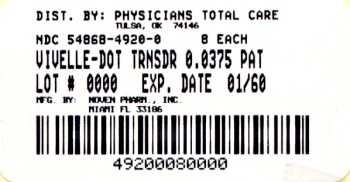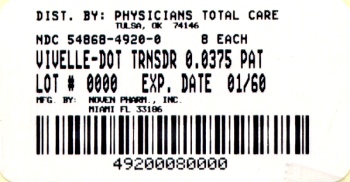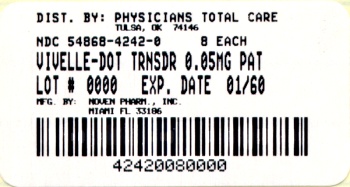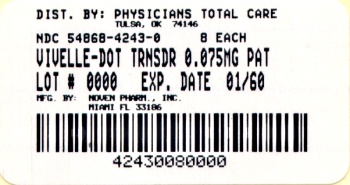Label: VIVELLE DOT- estradiol patch, extended release
-
Contains inactivated NDC Code(s)
NDC Code(s): 54868-4242-0, 54868-4243-0, 54868-4244-0, 54868-4862-0, view more54868-4920-0 - Packager: Physicians Total Care, Inc.
- This is a repackaged label.
-
Source NDC Code(s):
0078-0343,
0078-0344,
0078-0345,
0078-0346,
view more0078-0365
- Category: HUMAN PRESCRIPTION DRUG LABEL
Drug Label Information
Updated February 17, 2012
If you are a healthcare professional or from the pharmaceutical industry please visit this version.
- Download DRUG LABEL INFO: PDF XML
- Official Label (Printer Friendly)
- SPL UNCLASSIFIED SECTION
-
BOXED WARNING
(What is this?)
ESTROGENS INCREASE THE RISK OF ENDOMETRIAL CANCER
Close clinical surveillance of all women taking estrogens is important. Adequate diagnostic measures, including endometrial sampling when indicated, should be undertaken to rule out malignancy in all cases of undiagnosed persistent or recurring abnormal vaginal bleeding. There is no evidence that the use of “natural” estrogens results in a different endometrial risk profile than synthetic estrogens at equivalent estrogen doses. (See WARNINGS, Malignant Neoplasms, Endometrial Cancer.)
CARDIOVASCULAR AND OTHER RISKS
Estrogens with or without progestins should not be used for the prevention of cardiovascular disease. (See WARNINGS, Cardiovascular Disorders.)
The Women’s Health Initiative (WHI) study reported increased risks of myocardial infarction, stroke, invasive breast cancer, pulmonary emboli, and deep vein thrombosis in postmenopausal women (50 to 79 years of age), during 5 years of treatment with oral conjugated estrogens (CE 0.625 mg) combined with medroxyprogesterone acetate (MPA 2.5 mg) relative to placebo (see CLINICAL PHARMACOLOGY, Clinical Studies).
The Women’s Health Initiative Memory Study (WHIMS), a substudy of WHI, reported increased risk of developing probable dementia in postmenopausal women 65 years of age or older during 4 years of treatment with oral conjugated estrogens plus medroxyprogesterone acetate relative to placebo. It is unknown whether this finding applies to younger postmenopausal women or to women taking estrogen alone therapy. (See CLINICAL PHARMACOLOGY, Clinical Studies.)
Other doses of oral conjugated estrogens with medroxyprogesterone acetate, and other combinations and dosage forms of estrogens and progestins were not studied in the WHI clinical trials and, in the absence of comparable data, these risks should be assumed to be similar. Because of these risks, estrogens with or without progestins should be prescribed at the lowest effective doses and for the shortest duration consistent with treatment goals and risks for the individual woman.
-
DESCRIPTION
Vivelle-Dot® (estradiol transdermal system) contains estradiol in a multipolymeric adhesive. The system is designed to release estradiol continuously upon application to intact skin.
Five dosage strengths of Vivelle-Dot are available to provide nominal in vivo delivery rates of 0.025, 0.0375, 0.05, 0.075, or 0.1 mg of estradiol per day via the skin. Each corresponding system has an active surface area of 2.5, 3.75, 5.0, 7.5, or 10.0 cm2 and contains 0.39, 0.585, 0.78, 1.17, or 1.56 mg of estradiol USP, respectively. The composition of the systems per unit area is identical.
Estradiol USP is a white, crystalline powder, chemically described as estra-1,3,5 (10)-triene-3,17β-diol.
The structural formula is

The molecular formula of estradiol is C18H2402. The molecular weight is 272.39.
Vivelle-Dot is comprised of three layers. Proceeding from the visible surface toward the surface attached to the skin, these layers are (1) a translucent polyolefin film (2) an adhesive formulation containing estradiol, acrylic adhesive, silicone adhesive, oleyl alcohol, NF, povidone, USP and dipropylene glycol, and (3) a polyester release liner which is attached to the adhesive surface and must be removed before the system can be used.

----- (1) Backing ----- (2) Adhesive Containing Estradiol ----- (3) Protective Liner The active component of the system is estradiol. The remaining components of the system are pharmacologically inactive.
-
CLINICAL PHARMACOLOGY
Endogenous estrogens are largely responsible for the development and maintenance of the female reproductive system and secondary sexual characteristics. Although circulating estrogens exist in a dynamic equilibrium of metabolic interconversions, estradiol is the principal intracellular human estrogen and is substantially more potent than its metabolites, estrone and estriol, at the receptor level.
The primary source of estrogen in normally cycling adult women is the ovarian follicle, which secretes 70 to 500 mcg of estradiol daily, depending on the phase of the menstrual cycle. After menopause, most endogenous estrogen is produced by conversion of androstenedione, secreted by the adrenal cortex, to estrone by peripheral tissues. Thus, estrone and the sulfate conjugated form, estrone sulfate, are the most abundant circulating estrogens in postmenopausal women.
Estrogens act through binding to nuclear receptors in estrogen-responsive tissues. To date, two estrogen receptors have been identified. These vary in proportion from tissue to tissue.
Circulating estrogens modulate the pituitary secretion of the gonadotropins, luteinizing hormone (LH) and follicle stimulating hormone (FSH) through a negative feedback mechanism. Estrogens act to reduce the elevated levels of these hormones seen in postmenopausal women.
Pharmacokinetics
The skin metabolizes estradiol only to a small extent. In contrast, orally administered estradiol is rapidly metabolized by the liver to estrone and its conjugates, giving rise to higher circulating levels of estrone than estradiol. Therefore, transdermal administration produces therapeutic plasma levels of estradiol with lower circulating levels of estrone and estrone conjugates and requires smaller total doses than does oral therapy.
Absorption
In a multiple-dose study consisting of three consecutive system applications of the original formulation [Vivelle® (estradiol transdermal system)] which was conducted in 17 healthy, postmenopausal women, blood levels of estradiol and estrone were compared following application of these units to sites on the abdomen and buttocks in a crossover fashion. Systems that deliver nominal estradiol doses of approximately 0.0375 mg/day and 0.1 mg/day were applied to abdominal application sites while the 0.1 mg/day doses were also applied to sites on the buttocks. These systems increased estradiol levels above baseline within 4 hours and maintained respective mean levels of 25 and 79 pg/mL above baseline following application to the abdomen; slightly higher mean levels of 88 pg/mL above baseline were observed following application to the buttocks. At the same time, increases in estrone plasma concentrations averaged about 12 and 50 pg/mL, respectively, following application to the abdomen and 61 pg/mL for the buttocks. While plasma concentrations of estradiol and estrone remained slightly above baseline at 12 hours following removal of the systems in this study, results from another study show these levels to return to baseline values within 24 hours following removal of the systems.
Figure 1 illustrates the mean plasma concentrations of estradiol at steady-state during application of these patches at four different dosages.
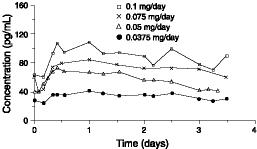
Figure 1Steady-State Estradiol Plasma Concentrations for Systems Applied to the AbdomenNonbaseline-corrected levels
The corresponding pharmacokinetic parameters are summarized in the table below.
Table 1 Steady-State Estradiol Pharmacokinetic Parameters for Systems Applied to the Abdomen (mean ± standard deviation) Nonbaseline-corrected data* Dosage
(mg/day)Cmax†
(pg/mL)Cavg‡
(pg/mL)Cmin (84 hr)§
(pg/mL)0.0375 46 ± 16 34 ± 10 30 ±10 0.05 83 ± 41 57 ± 23# 41 ± 11# 0.075 99 ± 35 72 ± 24 60 ± 24 0.1 133 ± 51 89 ± 38 90 ± 44 0.1¶ 145 ± 71 104 ± 52 85 ± 47 *Mean baseline estradiol concentration = 11.7 pg/mL
†Peak plasma concentration
‡Average plasma concentration
§Minimum plasma concentration at 84 hr
#Measured over 80 hr
¶Applied to the buttocks
Vivelle-Dot® (estradiol transdermal system), the revised formulation with smaller system sizes, was shown to be bioequivalent to the original formulation, Vivelle® (estradiol transdermal system), used in the clinical trials.
Distribution
No specific investigation of the tissue distribution of estradiol absorbed from Vivelle-Dot in humans has been conducted. The distribution of exogenous estrogens is similar to that of endogenous estrogens. Estrogens are widely distributed in the body and are generally found in higher concentrations in the sex hormone target organs. Estrogens circulate in the blood largely bound to sex hormone-binding globulin (SHBG) and albumin.
Metabolism
Exogenous estrogens are metabolized in the same manner as endogenous estrogens. Circulating estrogens exist in a dynamic equilibrium of metabolic interconversions. These transformations take place mainly in the liver. Estradiol is converted reversibly to estrone, and both can be converted to estriol, which is the major urinary metabolite. Estrogens also undergo enterohepatic recirculation via sulfate and glucuronide conjugation in the liver, biliary secretion of conjugates into the intestine, and hydrolysis in the gut followed by reabsorption. In postmenopausal women a significant portion of the circulating estrogens exist as sulfate conjugates, especially estrone sulfate, which serves as a circulating reservoir for the formation of more active estrogens.
Excretion
Estradiol, estrone and estriol are excreted in the urine along with glucuronide and sulfate conjugates. The half-life values calculated after dosing with the Vivelle-Dot ranged from 5.9 to 7.7 hours. After removal of the transdermal systems, serum concentrations of estradiol and estrone returned to baseline levels within 24 hours.
Drug Interactions
In vitro and in vivo studies have shown that estrogens are metabolized partially by cytochrome P450 3A4 (CYP3A4). Therefore, inducers or inhibitors of CYP3A4 may affect estrogen drug metabolism. Inducers of CYP3A4 such as St. John’s Wort preparations (Hypericum perforatum), phenobarbital, carbamazepine and rifampin may reduce plasma concentrations of estrogens, possibly resulting in a decrease in therapeutic effects and/or changes in the uterine bleeding profile. Inhibitors of CYP3A4 such as erythromycin, clarithromycin, ketoconazole, itraconazole, ritonavir and grapefruit juice may increase plasma concentrations of estrogens and may result in side effects.
Adhesion
Based on combined data from three short-term clinical trials consisting of 471 observations, 85% of Vivelle-Dot adhered completely to the skin over the 3.5-day wear period. Three (3%) of the systems detached and were reapplied or replaced during the 3.5-day wear period. Approximately 80% of the transdermal systems evaluated in these studies were Vivelle-Dot 0.05 mg/day.
Clinical Studies
Effects on vasomotor symptoms
In a pharmacokinetic study, Vivelle-Dot was shown to be bioequivalent to Vivelle. In two controlled clinical trials with Vivelle, of 356 subjects, the 0.075 and 0.1 mg doses were superior to placebo in relieving vasomotor symptoms at Week 4, and maintained efficacy through Weeks 8 and 12 of treatment. In this original study, the 0.0375 and 0.05 mg doses, however, did not differ from placebo until approximately Week 6, therefore, an additional 12-week placebo-controlled study in 255 patients was performed with Vivelle to establish the efficacy of the lowest dose of 0.0375 mg. The baseline mean daily number of hot flushes in these 255 patients was 11.5. Results at Weeks 4, 8, and 12 of treatment are shown in the figure below. (See Figure 2.)

Figure 2 Mean (SD) change from baseline in mean daily number of flushes for Vivelle® 0.0375 mg versus Placebo in a 12-week trial.
The 0.0375 mg dose was superior to placebo in reducing both the frequency and severity of vasomotor symptoms at Week 4 and maintained efficacy through Weeks 8 and 12 of treatment. All doses of Vivelle (0.0375 mg, 0.05 mg, 0.075 mg, and 0.1 mg) are effective for the control of vasomotor symptoms.
Effects on bone mineral density
Efficacy and safety of Vivelle in the prevention of postmenopausal osteoporosis have been studied in a 2-year double-blind, randomized, placebo-controlled, parallel group study. A total of 261 hysterectomized (161) and non-hysterectomized (100), surgically or naturally menopausal women (within 5 years of menopause), with no evidence of osteoporosis (lumbar spine bone mineral density within 2 standard deviations of average peak bone mass, i.e., ≥0.827 g/cm2) were enrolled in this study; 194 patients were randomized to one of the four doses of Vivelle (0.1, 0.05, 0.0375, or 0.025 mg/day) and 67 patients to placebo. Over 2 years, study systems were applied to the buttock or the abdomen twice a week. Non-hysterectomized women received oral medroxyprogesterone acetate (2.5 mg/day) throughout the study.
The study population comprised naturally (82%) or surgically (18%) menopausal, hysterectomized (61%) or non-hysterectomized (39%) women with a mean age of 52.0 years (range 27 to 62 years); the mean duration of menopause was 31.7 months (range 2 to 72 months). Two hundred thirty-two (89%) of randomized subjects (173 on active drug, 59 on placebo) contributed data to the analysis of percent change from baseline in bone mineral density (BMD) of the AP lumbar spine, the primary efficacy variable. Patients were given supplemental dietary calcium (1000 mg elemental calcium/day) but no supplemental vitamin D. There was an increase in BMD of the AP lumbar spine in all Vivelle dose groups; in contrast to this, a decrease in AP lumbar spine BMD was observed in placebo patients. All Vivelle doses were significantly superior to placebo (p<0.05) at all time points with the exception of Vivelle 0.05 mg/day at 6 months. The highest dose of Vivelle was superior to the three lower doses. There were no statistically significant differences in pairwise comparisons among the three lower doses. (See Figure 3.)

Figure 3 Bone mineral density - AP Lumbar spine Least squares means of percentage change from baseline All randomized patients with at least one post-baseline assessment available with last post-baseline observation carried forward
Analysis of percent change from baseline in femoral neck BMD, a secondary efficacy outcome variable, showed qualitatively similar results; all doses of Vivelle were significantly superior to placebo (p<0.05) at 24 months. The highest Vivelle dose was superior to placebo at all time points. A mixture of significant and non-significant results were obtained for the lower dose groups at earlier time points. The highest Vivelle dose was superior to the three lower doses, and there were no significant differences among the three lower doses at this skeletal site. (See Figure 4.)
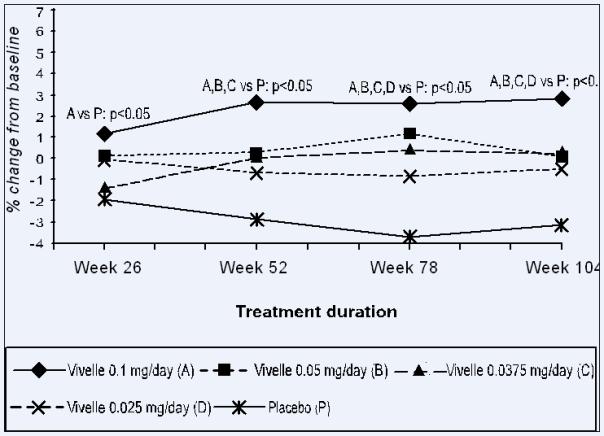
Figure 4 Bone mineral density - Femoral neck Least squares means of percentage change from baseline All randomized patients with at least one post-baseline assessment available with last post-baseline observation carried forward
The mean serum osteocalcin (a marker of bone formation) and urinary excretion of cross-link N-telopeptides of Type 1 collagen (a marker of bone resorption) decreased numerically in most of the active treatment groups relative to baseline. However, the decreases in both markers were inconsistent across treatment groups and the differences between active treatment groups and placebo were not statistically significant.
Women’s Health Initiative Studies
The Women’s Health Initiative (WHI) enrolled a total of 27,000 predominantly healthy postmenopausal women to assess the risks and benefits of the use of oral 0.625 mg conjugated estrogens (CE) per day alone or the use of oral 0.625 mg conjugated estrogens plus 2.5 mg medroxyprogesterone acetate (MPA) per day compared to placebo in the prevention of certain chronic diseases. The primary endpoint was the incidence of coronary heart disease (CHD) (non-fatal myocardial infarction and CHD death), with invasive breast cancer as the primary adverse outcome studied. A “global index” included the earliest occurrence of CHD, invasive breast cancer, stroke, pulmonary embolism (PE), endometrial cancer, colorectal cancer, hip fracture, or death due to other causes. The study did not evaluate the effects of CE or CE/MPA on menopausal symptoms.
The CE/MPA substudy was stopped early because, according to the predefined stopping rule, the increased risk of breast cancer and cardiovascular events exceeded the specified benefits included in the “global index”. Results of the CE/MPA substudy, which included 16,608 women (average age of 63 years, range 50 to 79, 83.9% White, 6.5% Black, 5.5% Hispanic), after an average follow-up of 5.2 years are presented in Table 2 below.
Table 2 Relative and Absolute Risk Seen in the CE/MPA Substudy of WHIa EventC RelativeRisk
CE/MPAvs.
Placebo at 5.2
Years (95% CI*)Placebo
n= 8102
Absolute Risk per
10,000 Women-YearsCE/MPA
n= 8506CHD events 1.29 (1.02-1.63) 30 37 Non-fatal MI 1.32 (1.02-1.72) 23 30 CHD death 1.18 (0.70-1.97) 6 7 Invasive breast cancerb 1.26 (1.00-1.59) 30 38 Stroke 1.41 (1.07-1.85) 21 29 Pulmonary embolism 2.13 (1.39-3.25) 8 16 Colorectal cancer 0.63 (0.43-0.92) 16 10 Endometrial cancer 0.83 (0.47-1.47) 6 5 Hip fracture 0.66 (0.45-0.98) 15 10 Death due to causes other
than the events above0.92 (0.74-1.14) 40 37 Global indexc 1.15 (1.03-1.28) 151 170 Deep vein thrombosisd 2.07 (1.49-2.87) 13 26 Vertebral fracturesd 0.66 (0.44-0.98) 15 9 Other osteoporotic fracturesd 0.77 (0.69-0.86) 170 131 a Adapted from JAMA, 2002: 288: 321-333
b Includes metastatic and non-metastatic breast cancer with the exception of in situ breast cancer
c A subset of the events was combined in a “global index”, defined as the earliest occurrence of CHD events, invasive breast cancer, stroke, pulmonary embolism, endometrial cancer, colorectal cancer, hip fracture, or death due to other causes
d Not included in Global index
* Nominal confidence intervals unadjusted for multiple looks and multiple comparisons
For those outcomes included in the “global index”, absolute excess risks per 10,000 women-years in the group treated with CE/MPA were 7 more CHD events, 8 more strokes, 8 more PEs, and 8 more invasive breast cancers, while absolute risk reductions per 10,000 women-years were 6 fewer colorectal cancers and 5 fewer hip fractures. The absolute excess risk of events included in the “global index” was 19 per 10,000 women-years. There was no difference between the groups in terms of all-cause mortality (See BOXED WARNINGS, WARNINGS, and PRECAUTIONS.)
Women’s Health Initiative Memory Study
The Women’s Health Initiative Memory Study (WHIMS), a substudy of WHI, enrolled 4,532 predominantly healthy postmenopausal women 65 years of age and older (47% were age 65 to 69 years, 35% were 70 to 74 years, and 18% were 75 years of age and older) to evaluate the effects of CE/MPA (0.625 mg conjugated estrogens plus 2.5 mg medroxyprogesterone acetate) on the incidence of probable dementia (primary outcome) compared with placebo.
After an average follow-up of 4 years, 40 women in the estrogen/progestin group (45 per 10,000 women-years) and 21 in the placebo group (22 per 10,000 women-years) were diagnosed with probable dementia. The relative risk of probable dementia in the hormone therapy group was 2.05 (95% CI, 1.21 to 3.48) compared to placebo. Differences between groups became apparent in the first year of treatment. It is unknown whether these findings apply to younger postmenopausal women. (See BOXED WARNINGS and WARNINGS, Dementia.)
-
INDICATIONS AND USAGE
Vivelle-Dot® (estradiol transdermal system) is indicated in:
- Treatment of moderate to severe vasomotor symptoms associated with the menopause.
- Treatment of moderate to severe symptoms of vulvar and vaginal atrophy associated with the menopause. When prescribing solely for the treatment of symptoms of vulvar and vaginal atrophy, topical vaginal products should be considered.
- Treatment of hypoestrogenism due to hypogonadism, castration, or primary ovarian failure.
- Prevention of postmenopausal osteoporosis. When prescribing solely for the prevention of postmenopausal osteoporosis, therapy should only be considered for women at significant risk of osteoporosis and non-estrogen medications should be carefully considered.
The mainstays for decreasing the risk of postmenopausal osteoporosis are weight-bearing exercise, adequate calcium and vitamin D intake, and when indicated, pharmacologic therapy. Postmenopausal women require an average of 1500 mg/day of elemental calcium. Therefore, when not contraindicated, calcium supplementation may be helpful for women with suboptimal dietary intake. Vitamin D supplementation of 400-800 IU/day may also be required to ensure adequate daily intake in postmenopausal women.
- Treatment of moderate to severe vasomotor symptoms associated with the menopause.
-
CONTRAINDICATIONS
Vivelle-Dot® (estradiol transdermal system) should not be used in women with any of the following conditions:
- Undiagnosed abnormal genital bleeding.
- Known, suspected or history of cancer of the breast.
- Known or suspected estrogen-dependent neoplasia.
- Active deep vein thrombosis, pulmonary embolism or a history of these conditions.
- Active or recent (e.g., within the past year) arterial thromboembolic disease (e.g., stroke, myocardial infarction).
- Liver dysfunction or disease.
- Vivelle-Dotshould not be used in patients with known hypersensitivity to its ingredients.
- Known or suspected pregnancy. There is no indication for Vivelle-Dot in pregnancy. There appears to be little or no increased risk of birth defects in children born to women who have used estrogens and progestins from oral contraceptives inadvertently during early pregnancy (see PRECAUTIONS).
- Undiagnosed abnormal genital bleeding.
-
WARNINGS
See BOXED WARNINGS.
The use of unopposed estrogens in women who have a uterus is associated with an increased risk of endometrial cancer.
1. Cardiovascular Disorders
Estrogen and estrogen/progestin therapy has been associated with an increased risk of cardiovascular events such as myocardial infarction and stroke, as well as venous thrombosis and pulmonary embolism (venous thromboembolism or VTE). Should any of these occur or be suspected, estrogens should be discontinued immediately.
Risk factors for arterial vascular disease (e.g., hypertension, diabetes mellitus, tobacco use, hypercholesterolemia, and obesity) and/or venous thromboembolism (e.g., personal history or family history of VTE, obesity, and systemic lupus erythematosus) should be managed appropriately.
a. Coronary Heart Disease and Stroke
In the Women’s Health Initiative (WHI) study, an increase in the number of myocardial infarctions and strokes has been observed in women receiving CE compared to placebo. These observations are preliminary. (See CLINICAL PHARMACOLOGY, Clinical Studies).
In the CE/MPA substudy of WHI an increased risk of coronary heart disease (CHD) events (defined as non-fatal myocardial infarction and CHD death) was observed in women receiving CE/MPA compared to women receiving placebo (37 vs 30 per 10,000 women-years). The increase in risk was observed in year one and persisted.
In the same substudy of WHI, an increased risk of stroke was observed in women receiving CE/MPA compared to women receiving placebo (29 vs 21 per 10,000 women-years). The increase in risk was observed after the first year and persisted.
In postmenopausal women with documented heart disease (n = 2,763, average age 66.7 years), a controlled clinical trial of secondary prevention of cardiovascular disease (Heart and Estrogen/Progestin Replacement Study; HERS) treatment with CE/MPA-0.625 mg/ 2.5 mg per day demonstrated no cardiovascular benefit. During an average follow-up of 4.1 years, treatment with CE/MPA did not reduce the overall rate of CHD events in postmenopausal women with established coronary heart disease. There were more CHD events in the CE/MPA-treated group than in the placebo group in year 1, but not during the subsequent years. Two thousand three hundred and twenty-one women from the original HERS trial agreed to participate in an open label extension of HERS, HERS II. Average follow-up in HERS II was an additional 2.7 years, for a total of 6.8 years overall. Rates of CHD events were comparable among women in the CE/MPA group and the placebo group in HERS, HERS II, and overall.
Large doses of estrogen (5 mg conjugated estrogens per day), comparable to those used to treat cancer of the prostate and breast, have been shown in a large prospective clinical trial in men to increase the risks of non-fatal myocardial infarction, pulmonary embolism, and thrombophlebitis.
b. Venous Thromboembolism (VTE)
In the Women’s Health Initiative (WHI) study, an increase in VTE has been observed in women receiving CE compared to placebo. These observations are preliminary (see CLINICAL PHARMACOLOGY, Clinical Studies).
In the CE/MPA substudy of WHI, a 2-fold greater rate of VTE, including deep venous thrombosis and pulmonary embolism, was observed in women receiving CE/MPA compared to women receiving placebo. The rate of VTE was 34 per 10,000 women-years in the CE/MPA group compared to 16 per 10,000 women-years in the placebo group. The increase in VTE risk was observed during the first year and persisted.
If feasible, estrogens should be discontinued at least 4 to 6 weeks before surgery of the type associated with an increased risk of thromboembolism, or during periods of prolonged immobilization.
2. Malignant Neoplasms
a. Endometrial Cancer
The use of unopposed estrogens in women with intact uteri has been associated with an increased risk of endometrial cancer. The reported endometrial cancer risk among unopposed estrogen users is about 2- to 12-fold greater than in non-users and appears dependent on duration of treatment and on estrogen dose. Most studies show no significant increased risk associated with the use of estrogens for less than 1 year. The greatest risk appears to be associated with prolonged use with increased risks of 15- to 24-fold for five to ten years or more, and this risk has been shown to persist for at least 8 to 15 years after estrogen therapy is discontinued.
Clinical surveillance of all women taking estrogen/progestin combinations is important. Adequate diagnostic measures, including endometrial sampling when indicated, should be undertaken to rule out malignancy in all cases of undiagnosed persistent or recurring abnormal vaginal bleeding. There is no evidence that the use of natural estrogens results in a different endometrial risk profile than synthetic estrogens of equivalent estrogen dose. Adding a progestin to estrogen therapy has been shown to reduce the risk of endometrial hyperplasia, which may be a precursor to endometrial cancer.
b. Breast Cancer
The use of estrogens and progestins by postmenopausal women has been reported to increase the risk of breast cancer. The most important randomized clinical trial providing information about this issue is the Women’s Health Initiative (WHI) substudy of CE/MPA (see CLINICAL PHARMACOLOGY, Clinical Studies). The results from observational studies are generally consistent with those of the WHI clinical trial and report no significant variation in the risk of breast cancer among different estrogens or progestins, doses, or routes of administration.
The CE/MPA substudy of WHI reported an increased risk of breast cancer in women who took CE/MPA for a mean follow-up of 5.6 years. Observational studies have also reported an increased risk for estrogen/progestin combination therapy, and a smaller increased risk for estrogen alone therapy, after several years of use. In the WHI trial and from observational studies, the excess risk increased with duration of use. From observational studies, the risk appeared to return to baseline in about five years after stopping treatment. In addition, observational studies suggest that the risk of breast cancer was greater, and became apparent earlier, with estrogen/progestin combination therapy as compared to estrogen alone therapy.
In the CE/MPA substudy, 26% of the women reported prior use of estrogen alone and/or estrogen/progestin combination hormone therapy. After a mean follow-up of 5.6 years during the clinical trial, the overall relative risk of invasive breast cancer was 1.24 (95% confidence interval 1.01-1.54), and the overall absolute risk was 41 vs 33 cases per 10,000 women-years, for CE/MPA compared with placebo. Among women who reported prior use of hormone therapy, the relative risk of invasive breast cancer was 1.86, and the absolute risk was 46 vs 25 cases per 10,000 women-years, for CE/MPA compared with placebo. Among women who reported no prior use of hormone therapy, the relative risk of invasive breast cancer was 1.09, and the absolute risk was 40 vs 36 cases per 10,000 women-years for CE/MPA compared with placebo. In the same substudy, invasive breast cancers were larger and diagnosed at a more advanced stage in the CE/MPA group compared with the placebo group. Metastatic disease was rare with no apparent difference between the two groups. Other prognostic factors such as histologic subtype, grade and hormone receptor status did not differ between the groups.
The use of estrogen plus progestin has been reported to result in an increase in abnormal mammograms requiring further evaluation. All women should receive yearly breast examinations by a healthcare provider and perform monthly breast self-examinations. In addition, mammography examinations should be scheduled based on patient age, risk factors, and prior mammogram results.
3. Dementia
In the Women’s Health Initiative Memory Study (WHIMS), 4,532 generally healthy postmenopausal women 65 years of age and older were studied, of whom 35% were 70 to 74 years of age and 18% were 75 or older. After an average follow-up of 4 years, 40 women being treated with CE/MPA (1.8%, n = 2,229) and 21 women in the placebo group (0.9%, n = 2,303) received diagnoses of probable dementia. The relative risk for CE/MPA vs placebo was 2.05 (95% confidence interval 1.21 – 3.48), and was similar for women with and without histories of menopausal hormone use before WHIMS. The absolute risk of probable dementia for CE/MPA vs placebo was 45 vs 22 cases per 10,000 women-years, and the absolute excess risk for CE/MPA was 23 cases per 10,000 women-years. It is unknown whether these findings apply to younger postmenopausal women. (See CLINICAL PHARMACOLOGY, Clinical Studies and PRECAUTIONS, Geriatric Use.) It is unknown whether these findings apply to estrogen alone therapy.
4. Gallbladder Disease
A 2- to 4-fold increase in the risk of gallbladder disease requiring surgery in postmenopausal women receiving estrogens has been reported.
5. Hypercalcemia
Administration of estrogen may lead to severe hypercalcemia in patients with breast cancer and bone metastases. If hypercalcemia occurs, use of the drug should be stopped and appropriate measures taken to reduce the serum calcium level.
6. Visual Abnormalities
Retinal vascular thrombosis has been reported in patients receiving estrogens. Discontinue medication pending examination if there is sudden partial or complete loss of vision, or a sudden onset of proptosis, diplopia, or migraine. If examination reveals papilledema or retinal vascular lesions, estrogens should be permanently discontinued.
-
PRECAUTIONS
A. General
1. Addition of a progestin when a woman has not had a hysterectomy. Studies of the addition of a progestin for 10 or more days of a cycle of estrogen administration, or daily with estrogen in a continuous regimen, have reported a lowered incidence of endometrial hyperplasia than would be induced by estrogen treatment alone. Endometrial hyperplasia may be a precursor to endometrial cancer. There are, however, possible risks that may be associated with the use of progestins with estrogens compared to estrogen-alone regimens. These include a possible increased risk of breast cancer.
2. Elevated Blood Pressure. In a small number of case reports, substantial increases in blood pressure have been attributed to idiosyncratic reactions to estrogens. In a large, randomized, placebo-controlled clinical trial, a generalized effect of estrogens on blood pressure was not seen. Blood pressure should be monitored at regular intervals with estrogen use.
3. Hypertriglyceridemia. In patients with pre-existing hypertriglyceridemia, estrogen therapy may be associated with elevations of plasma triglycerides leading to pancreatitis and other complications.
4. Impaired Liver Function and past history of cholestatic jaundice. Although transdermally administered estrogen therapy avoids first-pass hepatic metabolism, estrogens may be poorly metabolized in patients with impaired liver function. For patients with a history of cholestatic jaundice associated with past estrogen use or with pregnancy, caution should be exercised and in the case of recurrence, medication should be discontinued.
5. Hypothyroidism. Estrogen administration leads to increased thyroid-binding globulin (TBG) levels. Patients with normal thyroid function can compensate for the increased TBG by making more thyroid hormone, thus maintaining free T4 and T3 serum concentrations in the normal range. Patients dependent on thyroid hormone replacement therapy who are also receiving estrogens may require increased doses of their thyroid replacement therapy. These patients should have their thyroid function monitored in order to maintain their free thyroid hormone levels in an acceptable range.
6. Fluid Retention. Because estrogens may cause some degree of fluid retention, patients with conditions that might be influenced by this factor, such as cardiac or renal dysfunction, warrant careful observation when estrogens are prescribed.
7. Hypocalcemia. Estrogens should be used with caution in individuals with severe hypocalcemia.
8. Ovarian Cancer. The CE/MPA substudy of WHI reported that estrogen plus progestin increased the risk of ovarian cancer. After an average follow-up of 5.6 years, the relative risk for ovarian cancer for CE/MPA vs placebo was 1.58 (95% confidence interval 0.77 – 3.24) but was not statistically significant. The absolute risk for CE/MPA vs placebo was 4.2 vs 2.7 cases per 10,000 women-years. In some epidemiologic studies, the use of estrogen alone, in particular for ten or more years, has been associated with an increased risk of ovarian cancer. Other epidemiologic studies have not found these associations.
9. Exacerbation of Endometriosis. Endometriosis may be exacerbated with administration of estrogens. A few cases of malignant transformation of residual endometrial implants have been reported in women treated post-hysterectomy with estrogen alone therapy. For patients known to have residual endometriosis post-hysterectomy, the addition of progestin should be considered.
10. Exacerbation of Other Conditions. Estrogens may cause an exacerbation of asthma, diabetes mellitus, epilepsy, migraines or porphyria, systemic lupus erythematosus, and hepatic hemangiomas and should be used with caution in women with these conditions.
B. Patient Information.
Physicians are advised to discuss the Patient Information leaflet with patients for whom they prescribe Vivelle-Dot® (estradiol transdermal system).
C. Laboratory Tests.
Estrogen administration should be initiated at the lowest dose approved for the indication and then guided by clinical response, rather than by serum hormone levels (e.g., estradiol, FSH).
D. Drug/Laboratory Test Interactions.
- Accelerated prothrombin time, partial thromboplastin time, and platelet aggregation time; increased platelet count; increased factors II, VII antigen, VIII antigen, VIII coagulant activity, IX, X, XII, VII-X complex, II-VII-X complex; and beta-thromboglobulin; decreased levels of anti-factor Xa and antithrombin III; decreased antithrombin III activity; increased levels of fibrinogen and fibrinogen activity; increased plasminogen antigen and activity.
- Increased thyroid-binding globulin (TBG) leading to increased circulating total thyroid hormone levels, as measured by protein-bound iodine (PBI), T4 levels (by column or by radioimmunoassay) or T3 levels by radioimmunoassay. T3 resin uptake is decreased, reflecting the elevated TBG. Free T4 and free T3 concentrations are unaltered. Patients on thyroid replacement therapy may require higher doses of thyroid hormone.
- Other binding proteins may be elevated in serum (i.e., corticosteroid-binding globulin [CBG], sex hormone-binding globulin [SHBG]), leading to increased total circulating corticosteroids and sex steroids, respectively. Free hormone concentrations may be decreased. Other plasma proteins may be increased (angiotensinogen/renin substrate, alpha-1-antitrypsin, ceruloplasmin).
- Increased plasma HDL and HDL2 cholesterol subfraction concentrations, reduced LDL cholesterol concentration, increased triglycerides levels.
- Impaired glucose tolerance.
- Reduced response to metyrapone test.
E. Carcinogenesis, Mutagenesis, Impairment of Fertility.
Long-term, continuous administration of estrogen, with and without progestin, in women with and without a uterus, has shown an increased risk of endometrial cancer, breast cancer, and ovarian cancer. (See BOXED WARNINGS, WARNINGS, and PRECAUTIONS.)
Long-term, continuous administration of natural and synthetic estrogens in certain animal species increases the frequency of carcinomas of the breast, uterus, cervix, vagina, testis, and liver.
G. Nursing Mothers.
Estrogen administration to nursing mothers has been shown to decrease the quantity and quality of the milk. Detectable amounts of estrogens have been identified in the milk of mothers receiving this drug. Caution should be exercised when Vivelle-Dot is administered to a nursing woman.
H. Pediatric Use.
Estrogen therapy has been used for the induction of puberty in adolescents with some forms of pubertal delay. Safety and effectiveness in pediatric patients have not otherwise been established.
Large and repeated doses of estrogen over an extended time period have been shown to accelerate epiphyseal closure, which could result in short adult stature if treatment is initiated before the completion of physiologic puberty in normally developing children. If estrogen is administered to patients whose bone growth is not complete, periodic monitoring of bone maturation and effects on epiphyseal centers is recommended during estrogen administration.
Estrogen treatment of prepubertal girls also induces premature breast development and vaginal cornification, and may induce vaginal bleeding. (See INDICATIONS and DOSAGE AND ADMINISTRATION.)
I. Geriatric Use.
The safety and effectiveness in geriatric patients have not been established.
In the Women’s Health Initiative Memory Study, including 4,532 women 65 years of age and older, followed for an average of 4 years, 82% (n = 3,729) were 65 to 74 while 18% (n = 803) were 75 and over. Most women (80%) had no prior hormone therapy use. Women treated with conjugated estrogens plus medroxyprogesterone acetate were reported to have a two-fold increase in the risk of developing probable dementia. Alzheimer’s disease was the most common classification of probable dementia in both the conjugated estrogens plus medroxyprogesterone acetate group and the placebo group. Ninety percent of the cases of probable dementia occurred in the 54% of women that were older than 70. (See WARNINGS, Dementia.) It is unknown whether these findings apply to estrogen alone therapy.
- Accelerated prothrombin time, partial thromboplastin time, and platelet aggregation time; increased platelet count; increased factors II, VII antigen, VIII antigen, VIII coagulant activity, IX, X, XII, VII-X complex, II-VII-X complex; and beta-thromboglobulin; decreased levels of anti-factor Xa and antithrombin III; decreased antithrombin III activity; increased levels of fibrinogen and fibrinogen activity; increased plasminogen antigen and activity.
-
ADVERSE REACTIONS
See BOXED WARNINGS, WARNINGS and PRECAUTIONS.
Because clinical trials are conducted under widely varying conditions, adverse reaction rates observed in the clinical trials of a drug cannot be directly compared to rates in the clinical trials of another drug and may not reflect the rates observed in practice. The adverse reaction information from clinical trials does, however, provide a basis for identifying the adverse events that appear to be related to drug use and for approximating rates.
The following adverse events have been reported with Vivelle-Dot® (estradiol transdermal system) therapy:
Table 3 Summary of Most Frequently Reported Adverse Experiences/Medical Events Regardless of Relationship Reported at a Frequency ≥5% Vivelle
0.025 mg/day†
(N=47)
N (%)Vivelle
0.0375 mg/day†
(N=130)
N (%)Vivelle
0.05 mg/day†
(N=103)
N (%)Vivelle
0.075 mg/day†
(N=46)
N (%)Vivelle
0.1 mg/day†
(N=132)
N (%)Placebo
(N=157)
N (%)Gastrointestinal disorders Constipation 2 (4.3) 5 (3.8) 4 (3.9) 3 (6.5) 2 (1.5) 4 (2.5) Dyspepsia 4 (8.5) 12 (9.2) 3 (2.9) 2 (4.3) 0 10 (6.4) Nausea 2 (4.3) 8 (6.2) 4 (3.9) 0 7 (5.3) 5 (3.2) General disorders and
administration site
conditions***Influenza-like illness 3 (6.4) 6 (4.6) 8 (7.8) 0 3 (2.3) 10 (6.4) Pain NOS* 0 8 (6.2) 0 2 (4.3) 7 (5.3) 7 (4.5) Infections and infestations Influenza 4 (8.5) 4 (3.1) 6 (5.8) 0 10 (7.6) 14 (8.9) Nasopharyngitis 3 (6.4) 16 (12.3) 10 (9.7) 9 (19.6) 11 (8.3) 24 (15.3) Sinusitis NOS* 4 (8.5) 17 (13.1) 13 (12.6) 3 (6.5) 7 (5.3) 16 (10.2) Upper respiratory tract
infection NOS*3 (6.4) 8 (6.2) 11 (10.7) 4 (8.7) 6 (4.5) 9 (5.7) Investigations Weight increased 4 (8.5) 5 (3.8) 2 (1.9) 2 (4.3) 0 3 (1.9) Musculoskeletal and connective
tissue disordersArthralgia 0 11 (8.5) 4 (3.9) 2 (4.3) 5 (3.8) 9 (5.7) Back pain 4 (8.5) 10 (7.7) 9 (8.7) 4 (8.7) 14 (10.6) 10 (6.4) Neck pain 3 (6.4) 4 (3.1) 4 (3.9) 0 6 (4.5) 2 (1.3) Pain in limb 0 10 (7.7) 7 (6.8) 2 (4.3) 6 (4.5) 9 (5.7) Nervous system disorders Headache NOS* 7 (14.9) 35 (26.9) 32 (31.1) 23 (50.0) 34 (25.8) 37 (23.6) Sinus headache 0 12 (9.2) 5 (4.9) 5 (10.9) 2 (1.5) 8 (5.1) Psychiatric disorders Anxiety NEC** 3 (6.4) 5 (3.8) 0 0 2 (1.5) 4 (2.5) Depression 5 (10.6) 4 (3.1) 7 (6.8) 0 4 (3.0) 6 (3.8) Insomnia 3 (6.4) 6 (4.6) 4 (3.9) 2 (4.3) 2 (1.5) 9 (5.7) Reproductive system and
breast disordersBreast tenderness 8 (17.0) 10 (7.7) 8 (7.8) 3 (6.5) 17 (12.9) 0 Dysmenorrhea 0 0 0 3 (6.5) 0 0 Intermenstrual
bleeding3 (6.4) 9 (6.9) 6 (5.8) 0 14 (10.6) 7 (4.5) Respiratory, thoracic and
mediastinal disordersSinus congestion 0 4 (3.1) 3 (2.9) 3 (6.5) 6 (4.5) 7 (4.5) Vascular disorders Hot flushes NOS* 3 (6.4) 0 3 (2.9) 0 0 6 (3.8) Hypertension NOS* 2 (4.3) 0 3 (2.9) 0 0 2 (1.3) † Represents milligrams of estradiol delivered daily by each system
* NOS represents not otherwise specified
** NEC represents not elsewhere classified
*** Application site erythema and application site irritation were observed in a small number of patients (3.2% or less of patients across treatment groups.)
The following additional adverse reactions have been reported with estrogen and/or progestin therapy:
1. Genitourinary system. Changes in vaginal bleeding pattern and abnormal withdrawal bleeding or flow; breakthrough bleeding; spotting; dysmenorrhea, increase in size of uterine leiomyomata; vaginitis, including vaginal candidiasis; change in amount of cervical secretion; changes in cervical ectropion; ovarian cancer; endometrial hyperplasia; endometrial cancer.
2. Breasts. Tenderness, enlargement, pain, nipple discharge, galactorrhea; fibrocystic breast changes; breast cancer.
3. Cardiovascular. Deep and superficial venous thrombosis; pulmonary embolism; thrombophlebitis; myocardial infarction; stroke; increase in blood pressure.
4. Gastrointestinal. Nausea, vomiting; abdominal cramps, bloating; cholestatic jaundice; increased incidence of gallbladder disease; pancreatitis, enlargement of hepatic hemangiomas.
5. Skin. Chloasma or melasma, which may persist when drug is discontinued; erythema multiforme; erythema nodosum; hemorrhagic eruption; loss of scalp hair; hirsutism; pruritus, rash.
6. Eyes. Retinal vascular thrombosis; intolerance to contact lenses.
7. Central nervous system. Headache; migraine; dizziness; mental depression; chorea; nervousness; mood disturbances; irritability; exacerbation of epilepsy, dementia.
8. Miscellaneous. Increase or decrease in weight; reduced carbohydrate tolerance; aggravation of porphyria; edema; arthralgias; leg cramps; changes in libido; anaphylactoid/anaphylactic reactions including urticaria and angioedema; hypocalcemia; exacerbation of asthma; increased triglycerides.
- OVERDOSAGE
-
DOSAGE AND ADMINISTRATION
The adhesive side of Vivelle-Dot® (estradiol transdermal system) should be placed on a clean, dry area of the abdomen. Vivelle-Dot should not be applied to the breasts. Vivelle-Dot should be replaced twice weekly. The sites of application must be rotated, with an interval of at least 1 week allowed between applications to a particular site. The area selected should not be oily, damaged, or irritated. The waistline should be avoided, since tight clothing may rub the system off. The system should be applied immediately after opening the pouch and removing the protective liner. The system should be pressed firmly in place with the palm of the hand for about 10 seconds, making sure there is good contact, especially around the edges. In the event that a system should fall off, the same system may be reapplied. If the same system cannot be reapplied, a new system should be applied to another location. In either case, the original treatment schedule should be continued. If a woman has forgotten to apply a patch, she should apply a new patch as soon as possible. The new patch should be applied on the original treatment schedule. The interruption of treatment in women taking Vivelle-Dot might increase the likelihood of breakthrough bleeding, spotting and recurrence of symptoms.
Initiation of Therapy
When estrogen is prescribed for a postmenopausal woman with a uterus, progestin should also be initiated to reduce the risk of endometrial cancer. A woman without a uterus does not need progestin. Use of estrogen alone or in combination with a progestin, should be with the lowest effective dose and the shortest duration consistent with treatment goals and risks for the individual woman. Patients should be reevaluated periodically as clinically appropriate (e.g., 3-month to 6-month intervals) to determine whether treatment is still necessary (see BOXED WARNINGS and WARNINGS). For women who have a uterus, adequate diagnostic measures, such as endometrial sampling, when indicated, should be undertaken to rule out malignancy in cases of undiagnosed persistent or recurring abnormal vaginal bleeding.
Patients should be started at the lowest dose. The lowest effective dose of Vivelle-Dot has not been determined for any indication. For treatment of moderate to severe vasomotor symptoms and vulvar and vaginal atrophy associated with the menopause, start therapy with Vivelle-Dot 0.0375 mg/day applied to the skin twice weekly. For the prevention of postmenopausal osteoporosis, start therapy with Vivelle-Dot 0.025 mg/day applied to the skin twice weekly. The dosage may be adjusted as necessary. Reproductive system-associated adverse events were encountered more frequently in the highest dose group (0.1 mg/day) than in other active treatment groups or in placebo-treated patients.
In women not currently taking oral estrogens or in women switching from another estradiol transdermal therapy, treatment with Vivelle-Dot may be initiated at once. In women who are currently taking oral estrogens, treatment with Vivelle-Dot should be initiated 1 week after withdrawal of oral hormone therapy, or sooner if menopausal symptoms reappear in less than 1 week.
-
HOW SUPPLIED
Vivelle-Dot® (estradiol transdermal system), 0.0375 mg/day - each 3.75 cm2 system contains 0.585 mg of estradiol USP for nominal* delivery of 0.0375 mg of estradiol per day.
Patient Calendar Pack of 8 Systems……………………………………….NDC 54868-4920-0
Vivelle-Dot® (estradiol transdermal system), 0.05 mg/day - each 5.0 cm2 system contains 0.78 mg of estradiol USP for nominal* delivery of 0.05 mg of estradiol per day.
Patient Calendar Pack of 8 Systems……………………………………….NDC 54868-4242-0
Vivelle-Dot® (estradiol transdermal system), 0.075 mg/day - each 7.5 cm2 system contains 1.17 mg of estradiol USP for nominal* delivery of 0.075 mg of estradiol per day.
Patient Calendar Pack of 8 Systems……………………………………….NDC 54868-4243-0
Vivelle-Dot® (estradiol transdermal system), 0.1 mg/day - each 10.0 cm2 system contains 1.56 mg of estradiol USP for nominal* delivery of 0.1 mg of estradiol per day.
Patient Calendar Pack of 8 Systems……………………………………….NDC 54868-4244-0
________________________________________
*See DESCRIPTION.
Store at controlled room temperature at 25ºC (77°F).
Do not store unpouched. Apply immediately upon removal from the protective pouch.
REV: AUGUST 2004 T2004-65
-
PATIENT INFORMATION
Vivelle-Dot®
(estradiol transdermal system)
Read this PATIENT INFORMATION before you start using Vivelle-Dot® (estradiol transdermal system) and read all the information that you get each time you refill Vivelle-Dot. There may be new information. This information does not take the place of talking to your healthcare provider about your medical condition or your treatment.
The Vivelle-Dot® (estradiol transdermal system) patch that your healthcare provider has prescribed for you releases small amounts of an estrogen hormone through the skin.
This leaflet describes the risks and benefits of treatment with Vivelle-Dot. Vivelle-Dot is not for everyone. Talk to your healthcare provider if you have any questions or concerns about this medication.
WHAT IS THE MOST IMPORTANT INFORMATION I SHOULD KNOW ABOUT VIVELLE-DOT (AN ESTROGEN HORMONE)? - Estrogens increase the chances of getting cancer of the uterus.
Report any unusual vaginal bleeding right away while you are taking estrogens. Vaginal bleeding after menopause may be a warning sign of cancer of the uterus (womb). Your healthcare provider should check any unusual vaginal bleeding to find out the cause. - Do not use estrogens with or without progestins to prevent heart disease, heart attacks, or strokes.
Using estrogens with or without progestins may increase your chances of getting heart attacks, strokes, breast cancer, and blood clots. Using estrogens may increase your risk of dementia. You and your healthcare provider should talk regularly about whether you still need treatment with Vivelle-Dot. What is Vivelle-Dot®?
Vivelle-Dot is a patch that contains the estrogen hormone, estradiol. When applied to the skin as directed below, Vivelle-Dot releases estrogen through the skin into the bloodstream.
What is Vivelle-Dot used for?
Vivelle-Dot is used after menopause to:
● reduce moderate to severe hot flashes. Estrogens are hormones made by a woman’s ovaries. The ovaries normally stop making estrogens when a woman is between 45 and 55 years old. This drop in body estrogen levels causes the “change of life” or menopause (the end of monthly menstrual periods). Sometimes, both ovaries are removed during an operation before natural menopause takes place. The sudden drop in estrogen levels causes “surgical menopause.”
When the estrogen levels begin dropping, some women develop very uncomfortable symptoms, such as feelings of warmth in the face, neck, and chest or sudden strong feelings of heat and sweating (“hot flashes” or “hot flushes”). In some women, the symptoms are mild and they will not need estrogens. In other women, symptoms can be more severe. You and your healthcare provider should talk regularly about whether you still need treatment with Vivelle-Dot.
● treat moderate to severe dryness, itching and burning in or around the vagina. You and your healthcare provider should talk regularly about whether you still need treatment with Vivelle-Dot to control these problems. If you use Vivelle-Dot only to treat your dryness, itching, and burning in and around your vagina, talk with your healthcare provider about whether a topical vaginal product would be better for you.
● treat certain conditions in which a young woman’s ovaries do not produce enough estrogens naturally. ● help reduce your chances of getting osteoporosis (thin weak bones). Osteoporosis from menopause is a thinning of the bones that makes them weaker and easier to break. If you use Vivelle-Dot only to prevent osteoporosis from menopause, talk with your healthcare provider about whether a different treatment or medicine without estrogens might be better for you. You and your healthcare provider should talk regularly about whether you should continue with Vivelle-Dot.
Weight-bearing exercise, like walking or running, and taking calcium and vitamin D supplements may also lower your chances of getting postmenopausal osteoporosis. It is important to talk about exercise and supplements with your healthcare provider before starting them.
Who should not take Vivelle-Dot?
Do not start taking Vivelle-Dot if you:
● have unusual vaginal bleeding. ● currently have or have had certain cancers. Estrogens may increase the chances of getting certain types of cancers, including cancer of the breast or uterus. If you have or have had cancer, talk with your healthcare provider about whether you should take Vivelle-Dot. ● had a stroke or heart attack in the recent past (for example in the past year). ● currently have or have had blood clots. ● currently have or have had liver problems. ● are allergic to Vivelle-Dot or any of its ingredients. See the end of this leaflet for a list of ingredients in Vivelle-Dot. ● think you may be, or know that you are, pregnant. Tell your healthcare provider:
● if you are breast-feeding. The hormone in Vivelle-Dot can pass into your milk. ● about all of your medical problems. Your healthcare provider may need to check you more carefully if you have certain conditions such as asthma (wheezing), epilepsy (seizures), migraine, endometriosis, lupus, or problems with your heart, liver, thyroid, kidneys, or have high calcium levels in your blood. ● about all the medicines you take, including prescription and nonprescription medicines, vitamins, and herbal supplements. Some medicines may affect how Vivelle-Dot works. Vivelle-Dot may also affect how other medicines work. ● if you are going to have surgery or will be on bed rest. You may need to stop taking estrogens. How should I take Vivelle-Dot?
- Start at the lowest dose and talk to your healthcare provider about how well that dose is working for you.
- Estrogens should be used at the lowest dose possible for your treatment, only as long as needed. The lowest effective dose of Vivelle-Dot has not been determined for any indication. You and your healthcare provider should talk regularly (for example, every 3 to 6 months) about the dose you are taking and whether you still need treatment with Vivelle-Dot.
Application Instructions for Vivelle-Dot (estradiol transdermal system)
1. Determine Your Schedule for Your Twice-a-Week Application

- Decide upon which two days you will change your patch.
- Your Vivelle-Dot® (estradiol transdermal system) individual carton contains a calendar card printed on its inner flap. Mark the two-day schedule you plan to follow on your carton’s inner flap.
- BE CONSISTENT.
- If you forget to change your patch on the correct date, apply a new one as soon as you remember.
- No matter what day this happens, stick to the schedule you have marked on the inner flap of your carton (your calendar card).
2. Where to Apply Vivelle-Dot®
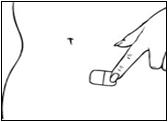
- Apply patch to lower abdomen, below the waistline. Avoid the waistline, since clothing may cause the patch to rub off.
- DO NOT APPLY PATCH TO BREASTS.
- When changing your patch, based on your twice-a-week schedule, apply your new patch to a different site. Do not apply a new patch to that same area for at least one week.
3. Before You Apply Vivelle-Dot®

-
Make sure your skin is:
- Clean (freshly washed), dry and cool.
- Free of any powder, oil, moisturizer or lotion.
- Free of cuts and/or irritations (rashes or other skin problems).
4. How to Apply Vivelle-Dot®
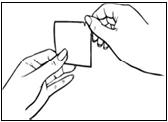
- Each patch is individually sealed in a protective pouch.
- Tear open the pouch at the tear notch (do not use scissors).
- Remove the patch.
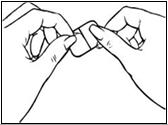
-
Apply the patch immediately after removing from pouch.
- Holding the patch with the rigid protective liner facing you, remove half of the liner, which covers the sticky surface of the patch.
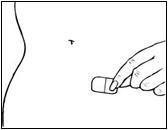
-
AVOID TOUCHING THE STICKY SIDE OF THE PATCH WITH YOUR FINGERS.
- Using the other half of the rigid protective liner as a handle, apply the sticky side of the patch to the selected area of the abdomen.
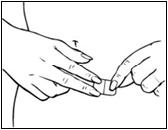
- Press the sticky side of the patch firmly into place.
- Smooth it down.
- While still holding the sticky side down, fold back the other half of the patch.

- Grasp an edge of the remaining protective liner and gently pull it off.
- AVOID TOUCHING THE STICKY SIDE OF THE PATCH WITH YOUR FINGERS.
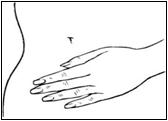
- Press the entire patch firmly into place with the palm of your hand.
- Continue to apply pressure, with the palm of your hand over the patch, for approximately 10 seconds.

- Make sure that the patch is properly adhered to your skin.
- Go over the edges with your finger to ensure good contact around the patch.
PLEASE NOTE:
● Contact with water while bathing, swimming or showering will not affect the patch. ● In the event that a patch should fall off, AVOID TOUCHING THE STICKY SIDE WITH YOUR FINGERS. Put the same patch back on a different site, making sure to press the patch firmly into place for at least 10 seconds. ● Continue to follow your original twice-a-week schedule you have marked on the inner flap of your individual carton (your calendar card). ● If necessary, if the same patch cannot be reapplied, apply a new patch at another location but continue to follow your original schedule. 5. How to Change and Discard Vivelle-Dot®
● When changing the patch, peel off the used patch slowly. ● Fold the used patch in half (sticky sides together) and discard appropriately, in the trash. ● PLEASE KEEP OUT OF THE REACH OF CHILDREN. ● If any adhesive residue remains on your skin after removing the patch, allow the area to dry for 15 minutes. Then, gently rub the area with oil or lotion to remove the adhesive from your skin. ● Keep in mind, the new patch must be applied to a different area of your abdomen. This area must be clean, dry, cool and free of powder, oil or lotion. What are the possible side effects of estrogens?
Less common but serious side effects include:
—— Breast cancer —— Cancer of the uterus —— Stroke —— Heart attack —— Blood clots —— Dementia —— Gallbladder disease —— Ovarian cancer These are some of the warning signs of serious side effects:
—— Breast lumps —— Unusual vaginal bleeding —— Dizziness and faintness —— Changes in speech —— Severe headaches —— Chest pain —— Shortness of breath —— Pains in your legs —— Changes in vision —— Vomiting Call your healthcare provider right away if you get any of these warning signs, or any other unusual symptom that concerns you.
Common side effects include:
—— Headache —— Breast pain —— Irregular vaginal bleeding or spotting —— Stomach/abdominal cramps, bloating —— Nausea and vomiting —— Hair loss Other side effects include:
—— High blood pressure —— Liver problems —— High blood sugar —— Fluid retention —— Enlargement of benign tumors of the uterus (“fibroids”) —— Vaginal yeast infection Other side effects of Vivelle-Dot may be possible. If you have questions, talk to your healthcare provider or pharmacist.
What can I do to lower my chances of a serious side effect with Vivelle-Dot?
● Talk with your healthcare provider regularly about whether you should continue taking Vivelle-Dot. ● If you have a uterus, talk to your healthcare provider about whether the addition of a progestin is right for you. ● See your healthcare provider right away if you get vaginal bleeding while taking Vivelle-Dot. ● Have a breast exam and mammogram (breast X-ray) every year unless your healthcare provider tells you something else. If members of your family have had breast cancer or if you have ever had breast lumps or an abnormal mammogram, you may need to have breast exams more often. ● If you have high blood pressure, high cholesterol (fat in the blood), diabetes, are overweight, or if you use tobacco, you may have higher chances of getting heart disease. Ask your healthcare provider for ways to lower your chances of getting heart disease. General information about safe and effective use of Vivelle-Dot
Medicines are sometimes prescribed for conditions that are not mentioned in patient information leaflets. Do not take Vivelle-Dot for conditions for which it was not prescribed. Do not give Vivelle-Dot to other people, even if they have the same symptoms you have. It may harm them. Keep Vivelle-Dot out of the reach of children.
This leaflet provides a summary of the most important information about Vivelle-Dot. If you would like more information, talk with your healthcare provider or pharmacist. You can ask for information about Vivelle-Dot that is written for health professionals. You can get more information by calling the toll-free number [(888-NOW-NOVA) (888-669-6682)].
What are the ingredients in Vivelle-Dot?
Vivelle-Dot is comprised of three layers. Proceeding from the visible surface toward the surface attached to the skin, these layers are (1) a translucent polyolefin film (2) an adhesive formulation containing estradiol, acrylic adhesive, silicone adhesive, oleyl alcohol, NF, povidone, USP and dipropylene glycol, and (3) a polyester release liner which is attached to the adhesive surface and must be removed before the system can be used.
The active component of the system is estradiol. The remaining components of the system are pharmacologically inactive.
Other Information
Do not store above 25ºC (77ºF). Do not store outside of their pouches. Apply immediately upon removal from the protective pouch.
T2004-66
REV: AUGUST 2004 T2004-65/T2004-66
100922-6
Manufactured by:
Noven Pharmaceuticals Inc.
Miami, FL 33186
Distributed by:
Novartis Pharmaceuticals Corporation
East Hanover, NJ 07936
© Novartis
- PRINCIPAL DISPLAY PANEL
- PRINCIPAL DISPLAY PANEL
- PRINCIPAL DISPLAY PANEL
- PRINCIPAL DISPLAY PANEL
-
INGREDIENTS AND APPEARANCE
VIVELLE DOT
estradiol patch, extended releaseProduct Information Product Type HUMAN PRESCRIPTION DRUG Item Code (Source) NDC:54868-4862(NDC:0078-0365) Route of Administration TRANSDERMAL Active Ingredient/Active Moiety Ingredient Name Basis of Strength Strength ESTRADIOL (UNII: 4TI98Z838E) (ESTRADIOL - UNII:4TI98Z838E) ESTRADIOL 0.025 mg in 1 d Inactive Ingredients Ingredient Name Strength DIPROPYLENE GLYCOL (UNII: E107L85C40) OLEYL ALCOHOL (UNII: 172F2WN8DV) POVIDONE (UNII: FZ989GH94E) Packaging # Item Code Package Description Marketing Start Date Marketing End Date 1 NDC:54868-4862-0 8 in 1 PACKET 1 1 in 1 POUCH 1 3.5 d in 1 PATCH Marketing Information Marketing Category Application Number or Monograph Citation Marketing Start Date Marketing End Date NDA NDA020538 07/23/2003 06/30/2005 VIVELLE DOT
estradiol patch, extended releaseProduct Information Product Type HUMAN PRESCRIPTION DRUG Item Code (Source) NDC:54868-4920(NDC:0078-0343) Route of Administration TRANSDERMAL Active Ingredient/Active Moiety Ingredient Name Basis of Strength Strength ESTRADIOL (UNII: 4TI98Z838E) (ESTRADIOL - UNII:4TI98Z838E) ESTRADIOL 0.0375 mg in 1 d Inactive Ingredients Ingredient Name Strength DIPROPYLENE GLYCOL (UNII: E107L85C40) OLEYL ALCOHOL (UNII: 172F2WN8DV) POVIDONE (UNII: FZ989GH94E) Packaging # Item Code Package Description Marketing Start Date Marketing End Date 1 NDC:54868-4920-0 8 in 1 PACKET 1 1 in 1 POUCH 1 3.5 d in 1 PATCH Marketing Information Marketing Category Application Number or Monograph Citation Marketing Start Date Marketing End Date NDA NDA020538 09/23/2003 VIVELLE DOT
estradiol patch, extended releaseProduct Information Product Type HUMAN PRESCRIPTION DRUG Item Code (Source) NDC:54868-4242(NDC:0078-0344) Route of Administration TRANSDERMAL Active Ingredient/Active Moiety Ingredient Name Basis of Strength Strength ESTRADIOL (UNII: 4TI98Z838E) (ESTRADIOL - UNII:4TI98Z838E) ESTRADIOL 0.05 mg in 1 d Inactive Ingredients Ingredient Name Strength DIPROPYLENE GLYCOL (UNII: E107L85C40) OLEYL ALCOHOL (UNII: 172F2WN8DV) POVIDONE (UNII: FZ989GH94E) Packaging # Item Code Package Description Marketing Start Date Marketing End Date 1 NDC:54868-4242-0 8 in 1 PACKET 1 1 in 1 POUCH 1 3.5 d in 1 PATCH Marketing Information Marketing Category Application Number or Monograph Citation Marketing Start Date Marketing End Date NDA NDA020538 06/10/2003 VIVELLE DOT
estradiol patch, extended releaseProduct Information Product Type HUMAN PRESCRIPTION DRUG Item Code (Source) NDC:54868-4243(NDC:0078-0345) Route of Administration TRANSDERMAL Active Ingredient/Active Moiety Ingredient Name Basis of Strength Strength ESTRADIOL (UNII: 4TI98Z838E) (ESTRADIOL - UNII:4TI98Z838E) ESTRADIOL 0.075 mg in 1 d Inactive Ingredients Ingredient Name Strength DIPROPYLENE GLYCOL (UNII: E107L85C40) OLEYL ALCOHOL (UNII: 172F2WN8DV) POVIDONE (UNII: FZ989GH94E) Packaging # Item Code Package Description Marketing Start Date Marketing End Date 1 NDC:54868-4243-0 8 in 1 PACKET 1 1 in 1 POUCH 1 3.5 d in 1 PATCH Marketing Information Marketing Category Application Number or Monograph Citation Marketing Start Date Marketing End Date NDA NDA020538 06/10/2003 VIVELLE DOT
estradiol patch, extended releaseProduct Information Product Type HUMAN PRESCRIPTION DRUG Item Code (Source) NDC:54868-4244(NDC:0078-0346) Route of Administration TRANSDERMAL Active Ingredient/Active Moiety Ingredient Name Basis of Strength Strength ESTRADIOL (UNII: 4TI98Z838E) (ESTRADIOL - UNII:4TI98Z838E) ESTRADIOL 0.1 mg in 1 d Inactive Ingredients Ingredient Name Strength DIPROPYLENE GLYCOL (UNII: E107L85C40) OLEYL ALCOHOL (UNII: 172F2WN8DV) POVIDONE (UNII: FZ989GH94E) Packaging # Item Code Package Description Marketing Start Date Marketing End Date 1 NDC:54868-4244-0 8 in 1 PACKET 1 1 in 1 POUCH 1 3.5 d in 1 PATCH Marketing Information Marketing Category Application Number or Monograph Citation Marketing Start Date Marketing End Date NDA NDA020538 06/10/2003 Labeler - Physicians Total Care, Inc. (194123980) Establishment Name Address ID/FEI Business Operations Physicians Total Care, Inc. 194123980 relabel
View Labeling Archives for this drug
VIVELLE DOT- estradiol patch, extended release
Number of versions: 1
RxNorm
VIVELLE DOT- estradiol patch, extended release
Get Label RSS Feed for this Drug
VIVELLE DOT- estradiol patch, extended release
NDC Codes
VIVELLE DOT- estradiol patch, extended release
If this SPL contains inactivated NDCs listed by the FDA initiated compliance action, they will be specified as such.

